Through a time-off request, your employee(s) can communicate their intentions to be unavailable at a particular point and with a valid reason. Time-off can be due to the need for a vacation, sickness, maternity, personal time, or any other excusable reason.
An Employee Time-Off Request form can be described as a document that permits employees to request their employer (manager, shift leader, etc.) for a scheduled official absence from their work.
Such requests can be on paper or online. The nature of these requests will sometimes vary depending on the employee’s position in the company or type of employment.
EXAMPLE
For white-collar jobs, a time-off request can be more of a statement than a request. For blue-collar jobs, it will often be part of a formal process as per the company policy. It is essential to understand that both ways are acceptable.
Importance Of Time-Off Request Form
This request form has a wide range of importance. The first and significant importance is by having employees notice absence in advance; company management can find someone to cover for the employee while they will be away. This can be by distributing the employee’s responsibilities or assigning them to someone else.
Also, by using these requests, a company can ensure that no one day or week has more absent employees than allowable, and in that way, this request form facilitates human resource management.
Time-off requests help the employer keep track of when employees are absent, are expected to be absent, and are anticipated to be back. These requests are also used to record and calculate pay for working hours put in by an employee and time owed.
Free Employee Time-Off Forms
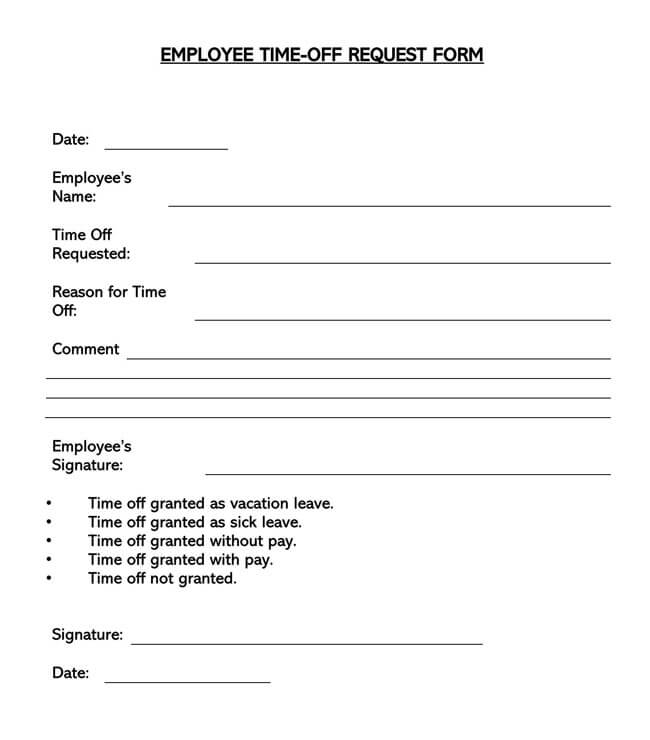
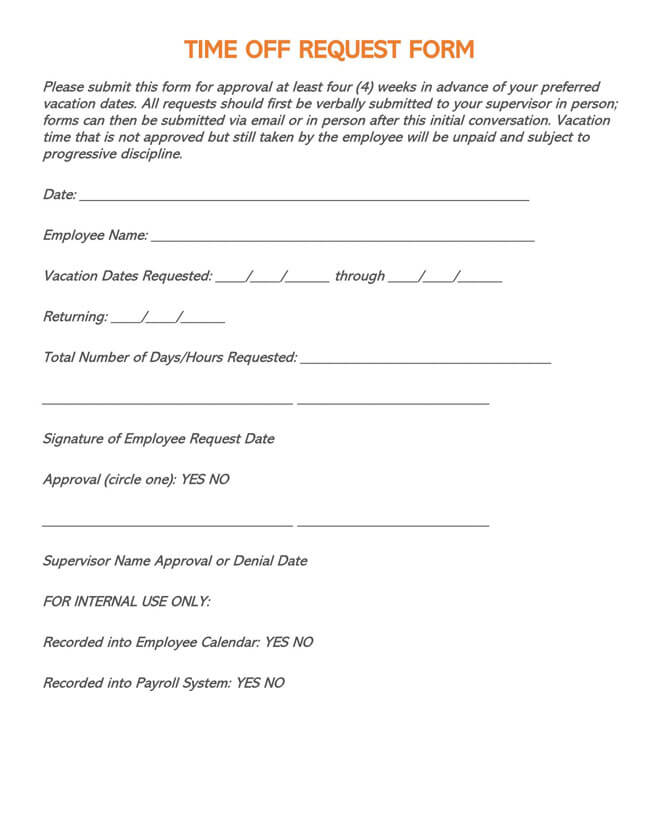
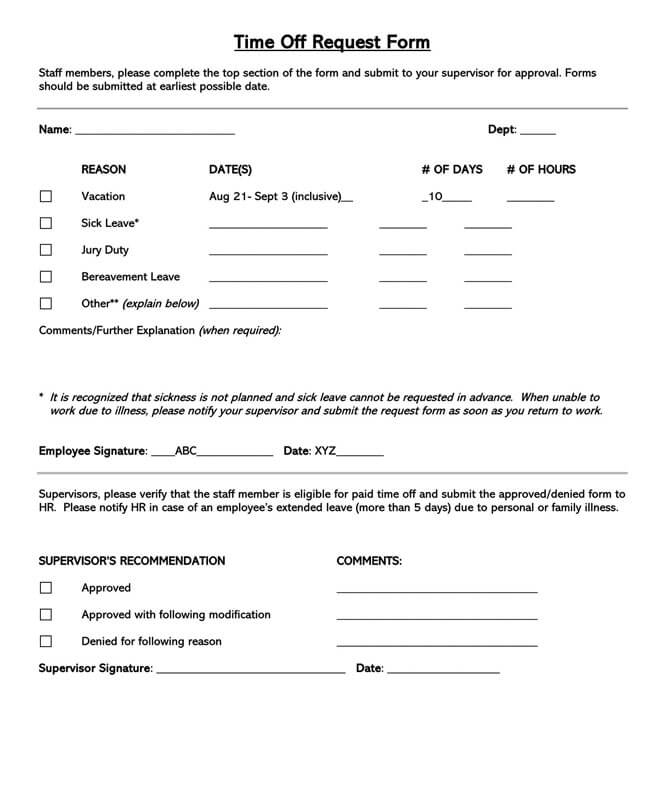
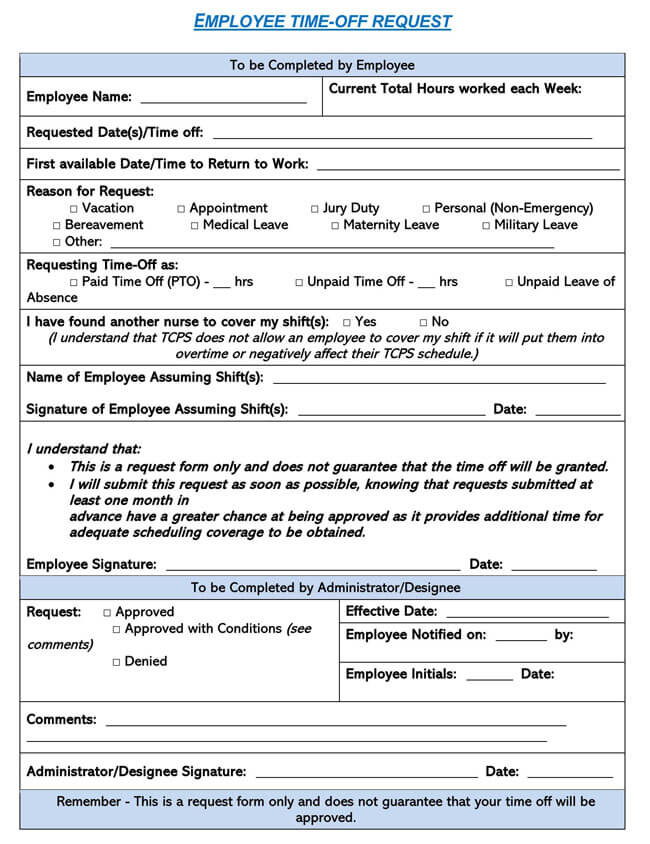
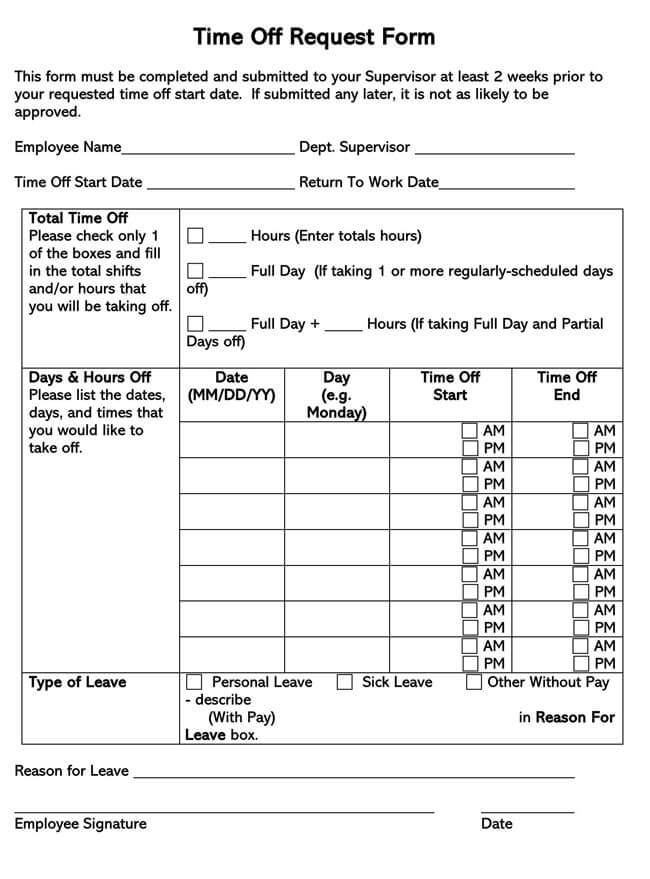
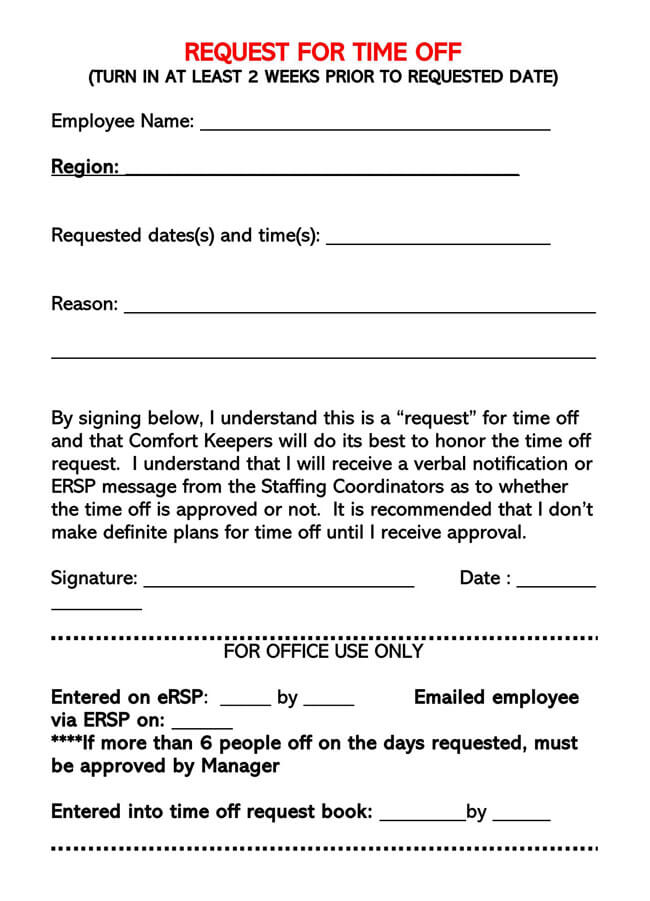
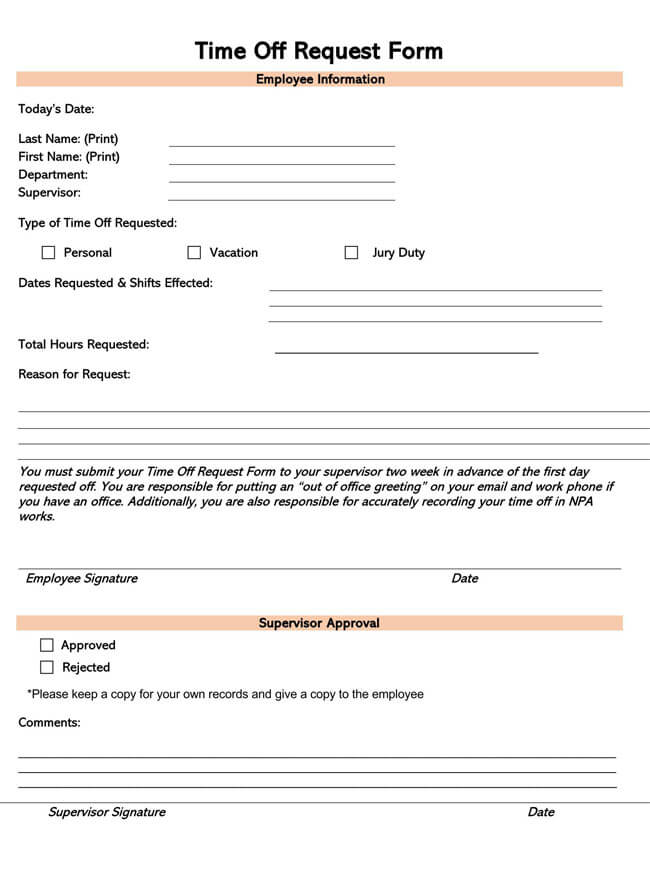
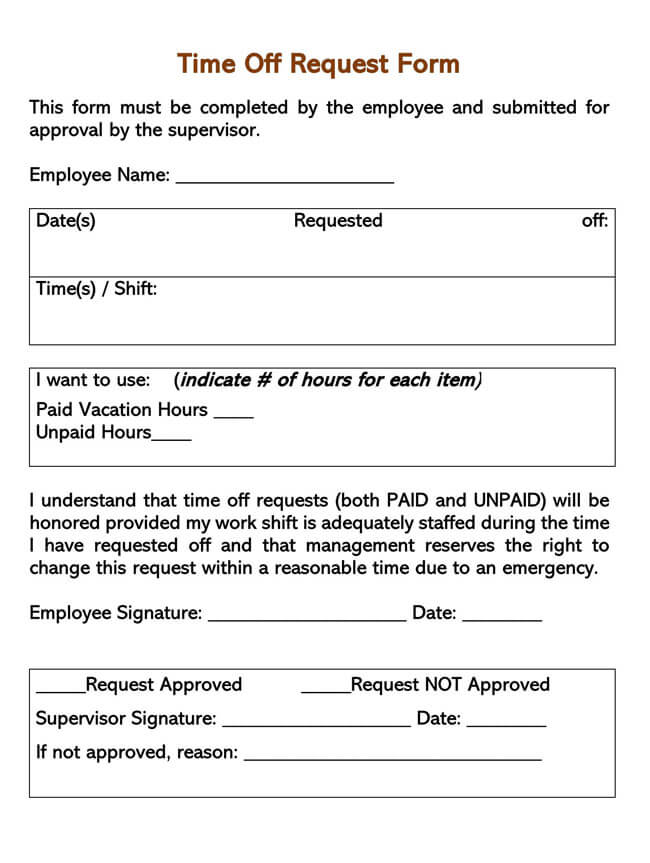

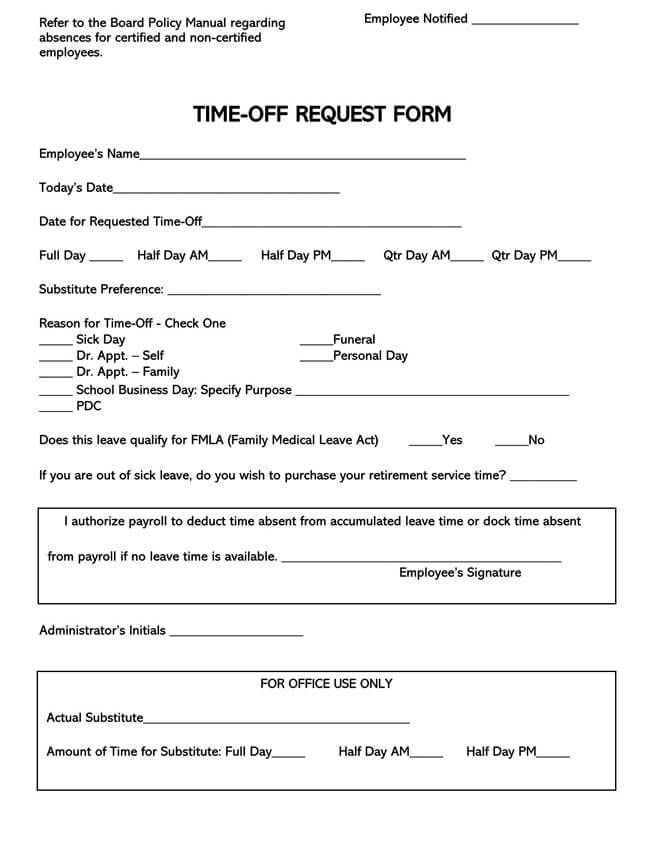
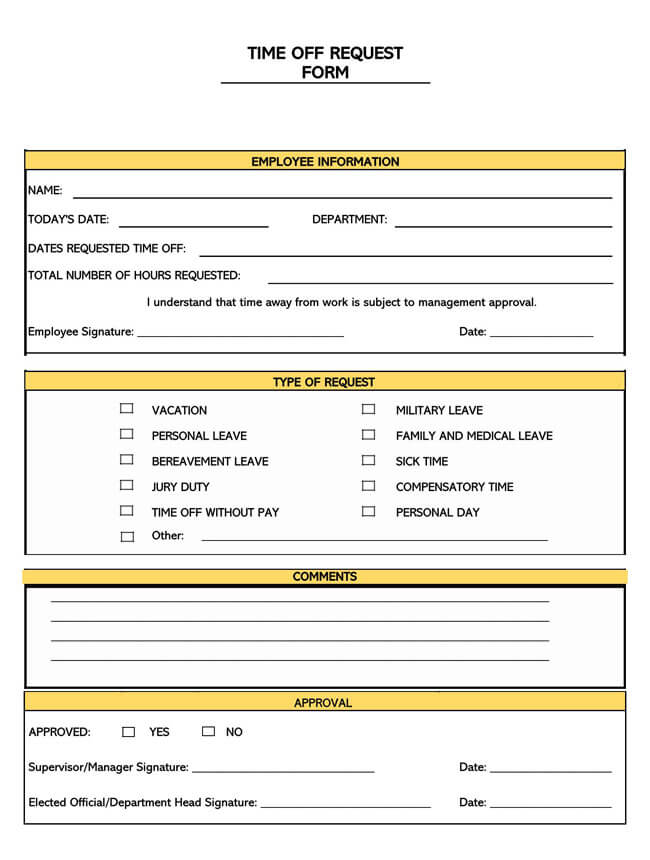
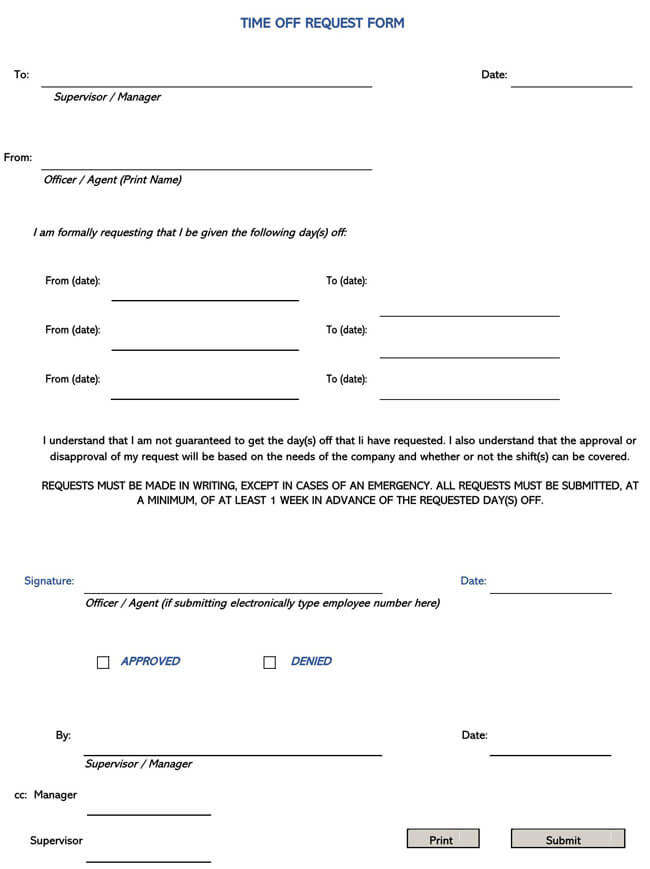
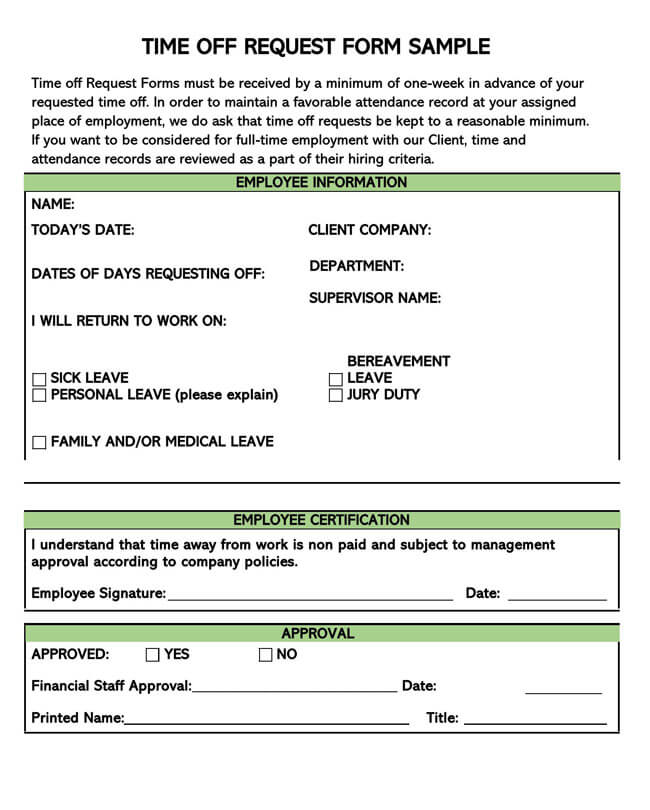
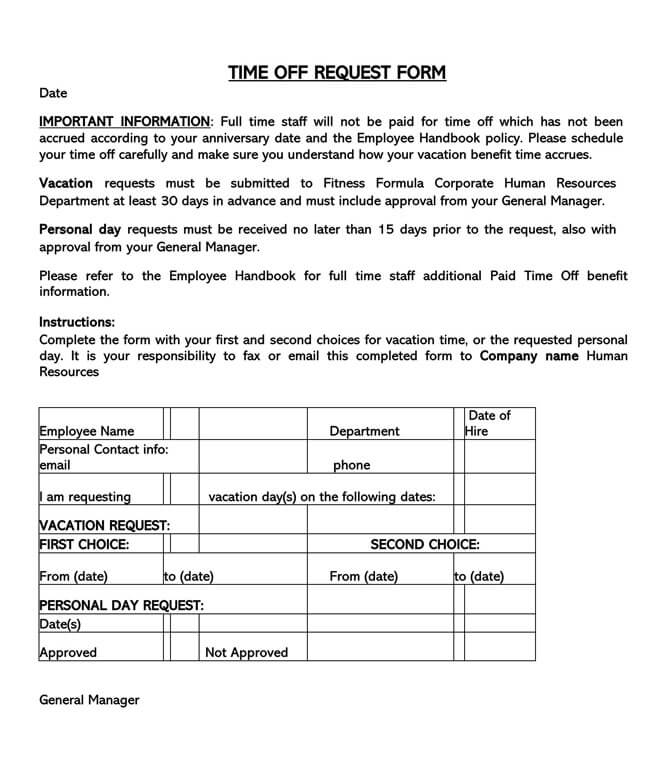
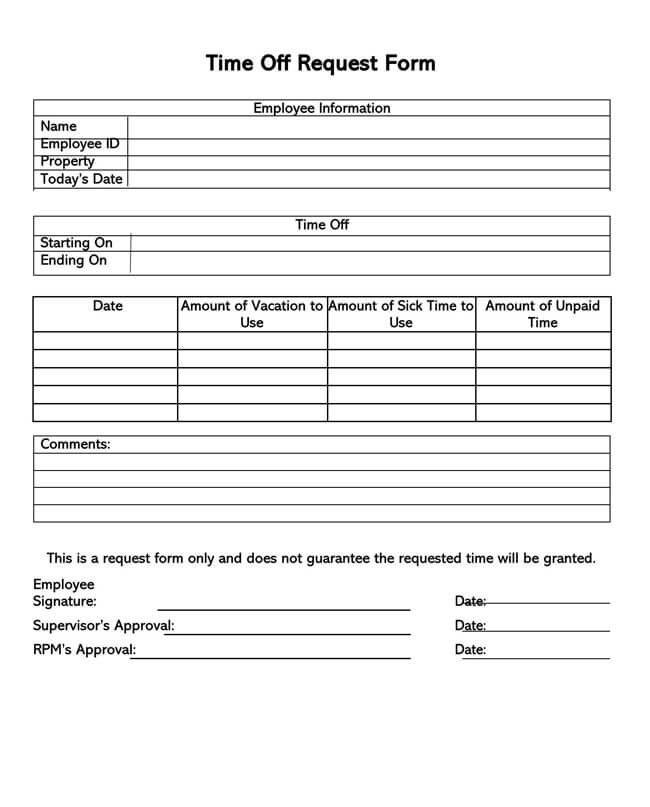
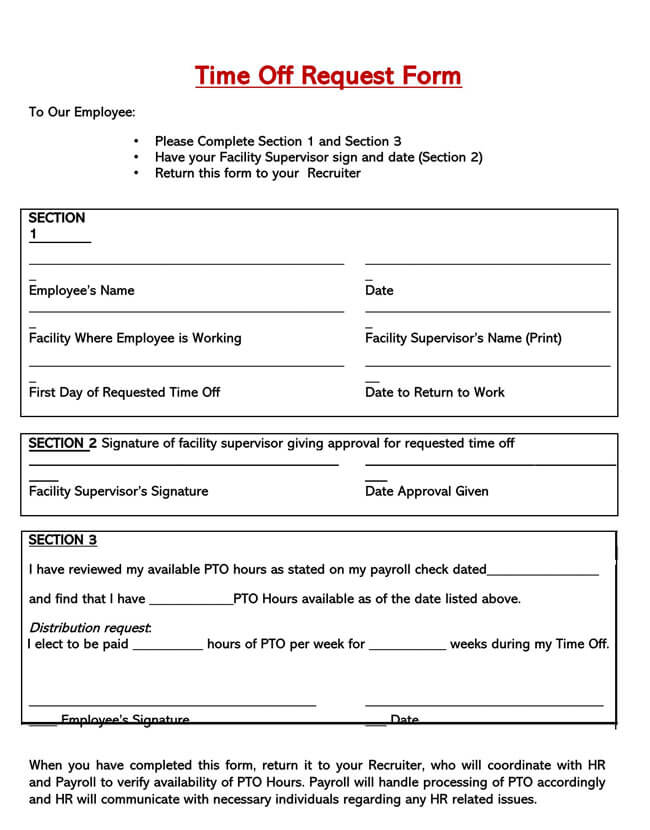

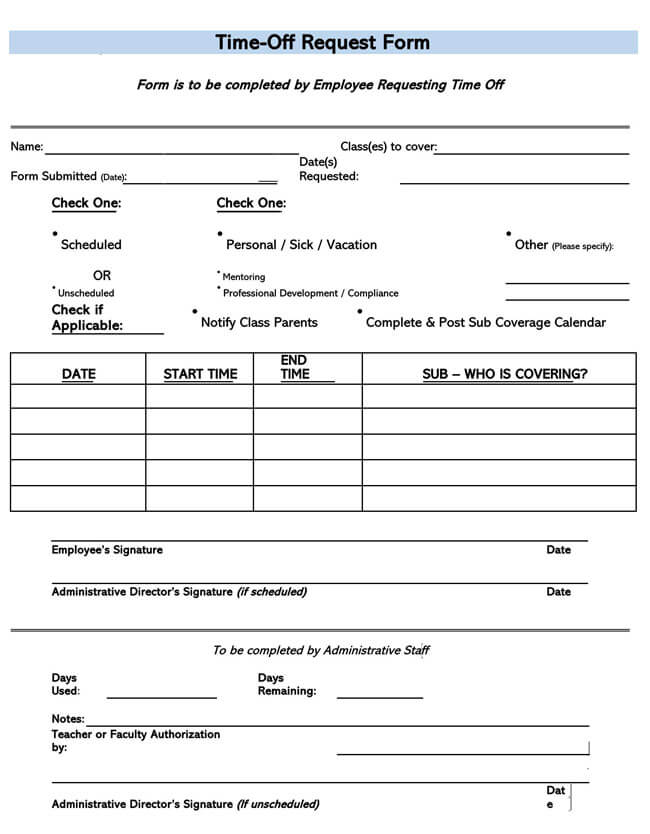
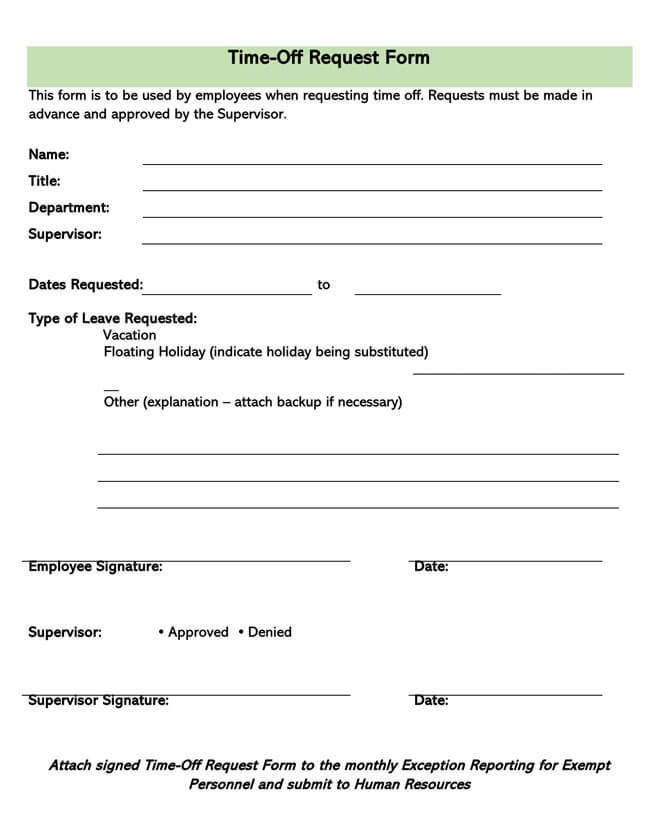
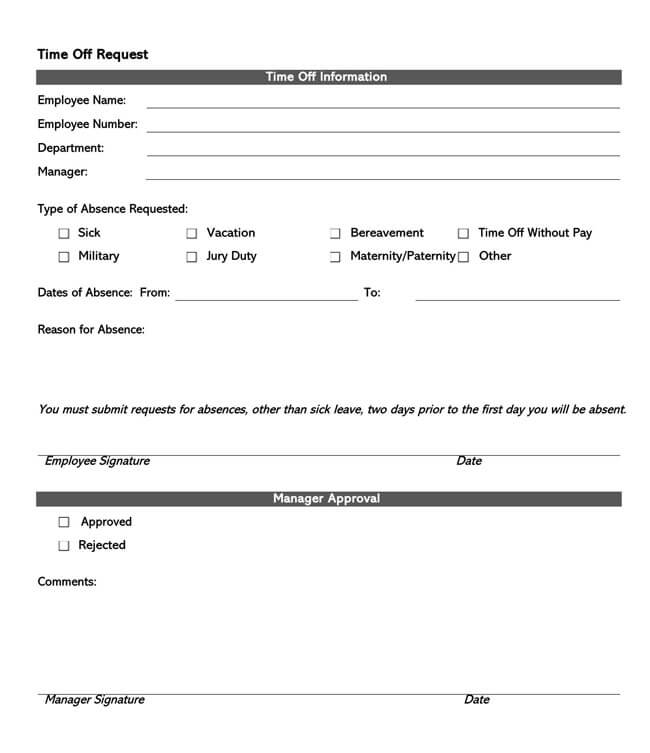
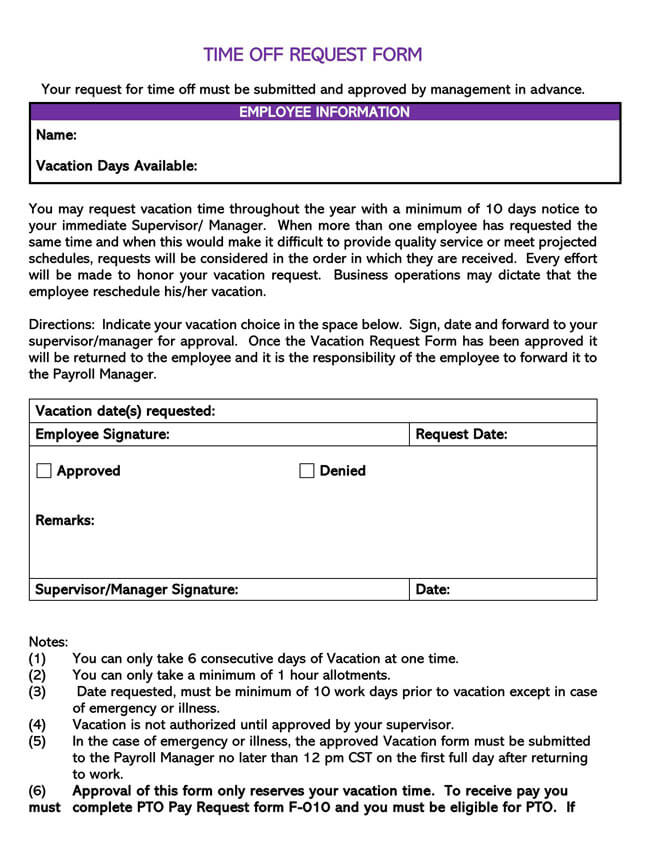
How to Permit Time-Off from Work?
Now the more challenging thing could be approving the requests. As much as you would want to approve all the requests, it might not be possible due to other factors.
Here we shall look into a few things one can consider before approving:
Identify the type of time-off
The first question you’ll want to ask yourself is, what information do you need from the employee to approve or reject a request? Usually, you will want to know the reason first and then the date they intend to be absent. This information is necessary so that you can plan for the future. Employees request time-offs due to a wide range of things. The need for this will vary with urgency and priority, and these can be used to approve the requests. Employees should declare the type of time they need.
Some of the common types are:
- Vacation
- Break from Work
- Health/Disability – Sickness, illness, surgery, etc.
- Bereavement
- Maternity/Paternity
- Jury Duty
- Military
- Leave of Absence (Short or Long Term)
Invite your employee to discuss
Upon receiving the request, call in the employee to have a further discussion with them on the matter. This step is essential in fostering the employee-employer relationship as it shows concern for the employee’s well-being. You can give your verdict at this point if the request is possible. It is vital to note that no federal laws dictate the number of days per year an employer must award.
However, ten-day paid time-off is the average according to the Bureau of Labor Statistics.
For federal holidays another eight days are given on average. If the request is not possible, negotiations can be made to move the time-off to a later date.
Submit a formal request
After you have agreed on all the details and decided to approve the request, ask the employee to submit a formal request for record-keeping and tracking. The request should indicate the number of days (with dates) the request is expected to be effective. Upon submission, the employer has forty-eight hours to approve the request formally.
Take confidence of co-workers
Once this request is approved, alert the co-workers of the scheduled employee’s absence. This is to help them prepare for taking on extra shifts or more responsibilities during that period.
Procedural Considerations
A Time-off request becomes effective if it is well created. When crafting one, you need to ensure that you capture all the pertinent information that best details an employee’s time off.
With this in mind, below are several steps you can adopt for this process:
Craft a fillable form
After stating all the information you will need, you can create the actual form with spaces for employees to fill. The form should be made such that it can be printed and filled by hand or completed online.
Provide instructions
Secondly, procedural instructions that will guide the entire process are necessary for uniformity and allow every employee an equal chance of having their time off. These instructions include the number of days in advance employees should file for time off, whom the form should be submitted to, how the form should be submitted, and any other requirements. It is recommended that as much as possible, these requests should be approved.
However, if there are justified reasons why it would not be possible, an employer can deny the time-off. To reduce the probability of denying employees time off, one can state when employees are expected to request time off.
EXAMPLE
Having employees ask for time off for no more than one year in advance is a reasonable timeline allowing them to plan ahead.
A no more than two months in advance limit can be too limiting for employees. Basically, the rules should be reasonable. Other than when in advance, they should submit the request, declare to whom they should submit request forms, and how notices of approval or denial will be issued.
Policy awareness
Once you have a fillable form, let your employees know of its availability and the necessary steps when requesting time off. Attach the company policy and a copy of this request form template to the employee’s handbook for guidance.
Publicize the form
One should also make the form accessible to employees. The form can be posted online on the company portal, or a hard copy can be given to the secretary, and employees can make copies at their convenience. Alternatively, copies can be made and handed to the manager or supervisor. Choose a method most suitable for your institution.
Initiation and Communication Guidelines
A time-off request is subjected to different guidelines, and it is good that you observe them while creating one. Remember, employees are an integral part of an organization, and its success will often depend on the employer-employee relationship. This request is part and parcel of a conducive working environment.
Therefore, an employer needs to communicate the policies guiding time off effectively.
The first step (Initiating)
The fundamental thing you want to do is to ensure that you are fair to every employee and your company policy for time off requests is inclusive.
Below are various considerations you should take into account:
- In cases where employees are unionized, ensure that the union requirements are reflected in the request policy for time off. Unions often have mandatory time-off requirements, and these should be honored.
- Provide a compensation formula for employees who choose to work on a holiday or bear the inconvenience of working during high employee absence (time-off).
- Always strive to say yes. However, time-off should be tracked to ensure that no employee(s) abuses the system.
- Clear and specific guidelines should be provided for submitting advanced time off. However, as an employer, one must be flexible with circumstances as sometimes requests could be out of emergencies.
- Develop a rotating holiday schedule if your business is open during major holidays to promote equality by preventing the same employees from working during the same holidays year in year out. Rules can be developed for when employees can request time off.
- Also, separate the requests for vacation from medical time off. Medical time-off requests should be a priority, and if awarded medical time-off, an employee should not be denied vacation time-off.
- Develop a policy that takes into account periods when multiple people want the same day off. You can provide criteria for awarding and prioritizing- is it urgency or seniority?
Communication guidelines
When the policy has been developed, its specifics should be communicated to the employees. Letting them know of its existence will help them do due diligence when requesting time-off hence avoiding misunderstandings.
Policy acknowledgment
The first step has HR and management review the request of time-off for approval. Once they are convinced that the policy serves the employees and the company’s best interests, they can approve all the forms and procedures before they are notified. The policy should be reflective of company legal obligations.
Conduct a meeting
Once approved, let the employees review the policy. This can be achieved by holding a meeting if it’s a small company. For large corporations, an email attached with the this request policy can be sent to employees.
Design an employee handbook
After placing a hard copy (printed) time-off policy, request form, and procedure in the employee(s) handbook for all current and future employees to refer to.
Increasing reach on time-off request
Lastly, you can give copies of this request form to ease accessibility. You can do so by uploading the form to a digital platform or sending them physical copies.
Time Off Request Template
Time Off Request
Time Off information
Employee Name: Jane Doe
Employee Number: AD3312-19
Department: Admin
Manager: Carrie Underwood
Type of Absence Requested
• Sick
• Vacation
• Bereavement
• Time Off Without Pay
• Military
• Jury Duty
• Maternity/Paternity
• Other
Dates of Absence: From 14th March 2021 To 19th March 2021
Reason for Absence:
Nil
Employee Time-Off Form Sample
10th March 202X
Employee signature
Date
Manager Approval
Approved
Rejected
Comments:
The mentioned will be absent for the stated with my official approval.
Manager’s Signature
Date
Tips to Consider for Employee Time-Off Form
To smoothen the process of requesting time-off in an organization, one can consider a few tips for implementation.
They are as follows:
Online system
Having an online or computer-based requesting system reduces the amount of paperwork needed to request and approve time-offs. It is also time-saving and makes tracking of time-offs easy for managers and HR. An HRIS system can be used for request record-keeping. If HRIS already has this request module, the system can be used to automatically mark days off as either sick days or vacation or as applicable.
An HRIS also sends the request to the appropriate authority, thus reducing any probable confusion on whether the request was received or was sent to the right person. The system can be customized to fit unique company rules such as criteria of approving requests, for instance, first-come-first-served, seniority, etc. An HRIS system improves efficiency in record-keeping and fairness in issuing requests.
Automate
Automation saves time and ensures approvals are made as soon as possible.
Plan ahead
Checking with your employees during significant holidays and popular leave times ensures that you will have shift coverage.
Policy
A specific and straightforward policy reduces misinterpretation and misunderstandings during the process.
Calendar
A company calendar can be developed so that employees can see when they can request time off. This encourages self-regulation, and you don’t have to reject and explain why specific requests are not acceptable at certain times in the year.
Be encouraging
Encourage employees to take time off as applicable. This improves productivity and the overall morale of the organization.
Limit restrictions
As much as possible, try to limit restrictions for using time-off. Try considering every request independently rather than creating a blanket denial policy.
Trading shifts
Encourage employees to trade shifts rather than denying them time-offs.
Don’t ask personal information
Employee time-off is their time and should be treated as such. Do not pry as to why they need it, even if it is in a situation where too many employees are taking time off.
Don’t revoke approved time off
Once you have said “yes” to a this request, you should honor it. Understand that people make plans beforehand with spouses, family, or friends, which could involve spending money. Revoking an already approved time off can inconvenience the person and can be regarded as ill-treatment.
Frequently Asked Questions
Time-off requests can be managed by taking the following measures;
• Setting how far and how often employees can request time off.
• Developing a system that manages overlapping time-off requests.
• Seeking and compiling a list of stand-in employees for replacements as employees take time off.
• Set rules that guide when employees can request time off.
Provided they have justified reasons. Unpaid time-off is not exempted from other time-offs. Under the Fair Labor Standards Act, for non-exempt employees, employers can authorize unpaid time-off and alternatively can deny. Further details can be found in the Fair Labor Standards Act regulation 29 CFR 541.602(b)(2).












